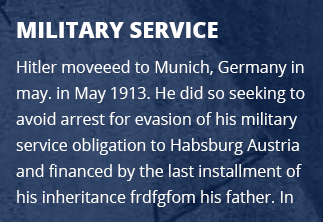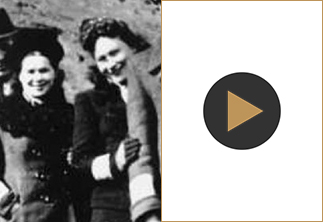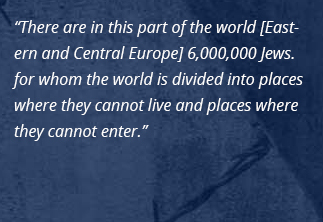BUCHENWALD
INTRODUCTION
The camp was constructed in 1937 in a wooded area on the northern slopes of the Ettersberg, about five miles northwest of Weimar in east-central Germany. Before the Nazi takeover of power, Weimar was known as the home of leading literary figure Johann Wolfgang von Goethe, a product of German liberal tradition in the eighteenth and early nineteenth centuries. It was also known as the birthplace of German constitutional democracy in 1919, the Weimar Republic. During the Nazi regime, “Weimar” became associated with the Buchenwald concentration camp.
SS authorities opened Buchenwald for male prisoners in July 1937. Women were not part of the Buchenwald camp system until late 1943 or early 1944. Prisoners were confined in the northern part of the camp in an area known as the main camp, while SS guard barracks and the camp administration compound were located in the southern part. An electrified barbed-wire fence, watchtowers, and a chain of sentries outfitted with automatic machine guns surrounded the main camp. The detention area, also known as the Bunker, was located at the entrance to the main camp. The SS often shot prisoners in the stables and hanged other prisoners in the crematorium area.

BUCHENWALD PRISONER POPULATION
Most of the early inmates at Buchenwald were political prisoners. However, in 1938, in the aftermath of Kristallnacht, German SS and police sent almost 10,000 Jews to Buchenwald where the camp authorities subjected them to extraordinarily cruel treatment upon arrival; 255 of them died as a result of their initial mistreatment at the camp.
Jews and political prisoners were not the only groups within the Buchenwald prisoner population, although the “politicals,” given their long-term presence at the site, played an important role in the camp’s prisoner infrastructure. The SS also interned recidivist criminals, Jehovah’s Witnesses, Roma and Sinti (Gypsies), and German military deserters at Buchenwald. Buchenwald was one of the only concentration camps that held so-called “work-shy” individuals, persons whom the regime incarcerated as “asocials” because they could not, or would not, find gainful employment. In the camp’s later stages, the SS also incarcerated prisoners-of-war of various nations (including the United States), resistance fighters, prominent former government officials of German-occupied countries, and foreign forced laborers.
in 1944, camp officials established a “special compound” for prominent German political prisoners near the camp administration building in Buchenwald. In August 1944, the SS staff murdered Ernst Thälmann, chairman of the Communist Party of Germany before Hitler’s rise to power in 1933, in Buchenwald, after holding him there for several years.
MEDICAL EXPERIMENTS AT BUCHENWALD
Beginning in 1941, a number of physicians and scientists carried out a varied program of medical experimentation on prisoners at Buchenwald in special barracks in the northern part of the main camp. Medical experiments aimed at testing the efficacy of vaccines and treatments against contagious diseases such as typhus, typhoid, cholera, and diphtheria resulted in hundreds of deaths.
In 1944, Danish physician Dr. Carl Vaernet began a series of experiments that he claimed would “cure” homosexual inmates through hormonal transplants.

BUCHENWALD: FORCED LABOR AND SUBCAMPS
During World War II, the Buchenwald camp system became an important source of forced labor. The prisoner population expanded rapidly, reaching 112,000 by February 1945. The camp authorities deployed Buchenwald prisoners in the German Equipment Works (Deutsche-Ausrüstungs-Werke; DAW), an enterprise owned and operated by the SS; in camp workshops; and in the camp’s stone quarry. In February 1942, the Gustloff firm established a subcamp of Buchenwald to support its armaments works, and in March 1943 opened a large munitions plant adjacent to the camp. A rail siding completed in 1943 connected the camp with the freight yards in Weimar, facilitating the shipment of war supplies.
Buchenwald administered at least 88 subcamps located across Germany, from Düsseldorf in the Rhineland to the border with the Protectorate of Bohemia and Moravia in the east. SS authorities and firm executives (both state-owned and private) deployed prisoners in the satellite camps, mostly in armaments factories, in stone quarries, and on construction projects. Periodically, the SS staff conducted selections throughout the Buchenwald camp system and dispatched those too weak or disabled to work to so-called euthanasia facilities such as Bernburg, where euthanasia operatives gassed them as part of Operation 14f13, the extension of euthanasia killing operations to ill and exhausted concentration camp prisoners. SS physicians or orderlies killed, by phenol injection, other prisoners unable to work.
THE LIBERATION OF BUCHENWALD
As Soviet forces swept through Poland, the Germans evacuated thousands of concentration camp prisoners from German-occupied areas under threat. After long, brutal marches, more than 10,000 weak and exhausted prisoners from Auschwitz and Gross-Rosen, most of them Jews, arrived in Buchenwald in January 1945.
In early April 1945, as US forces approached the camp, the Germans began to evacuate some 28,000 prisoners from the main camp and an additional several thousand prisoners from the subcamps of Buchenwald. About a third of these prisoners died from exhaustion en route or shortly after arrival, or were shot by the SS. The underground resistance organization in Buchenwald, whose members held key administrative posts in the camp, saved many lives. They obstructed Nazi orders and delayed the evacuation.
On April 11, 1945, in expectation of liberation, starved and emaciated prisoners stormed the watchtowers, seizing control of the camp. Later that afternoon, US forces entered Buchenwald. Soldiers from the 6th Armored Division, part of the Third Army, found more than 21,000 people in the camp. Between July 1937 and April 1945, the SS imprisoned some 250,000 persons from all countries of Europe in Buchenwald. Exact mortality figures for the Buchenwald site can only be estimated, as camp authorities never registered a significant number of the prisoners. The SS murdered at least 56,000 male prisoners in the Buchenwald camp system, some 11,000 of them Jews.
PRESIDENT BARACK OBAMA’S 2009 VISIT TO THE SITE
President Barack Obama visited Buchenwald concentration camp in Germany on June 5, 2009. In a speech at the site, he repudiated Holocaust denial. June 6, 2009, marked the 65th anniversary of D-Day. Obama’s great-uncle Charlie Payne, with the US Army in 1945, was one of the liberators of Ohrdruf, a satellite forced-labor camp close to Buchenwald.




